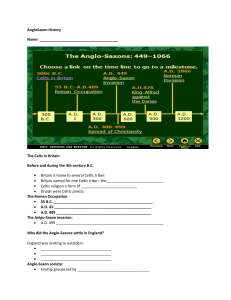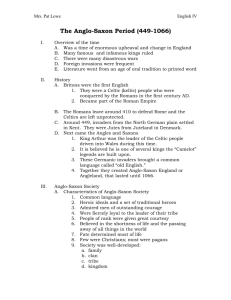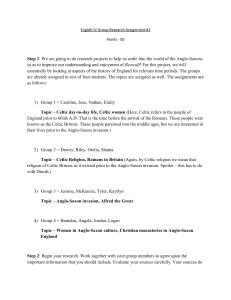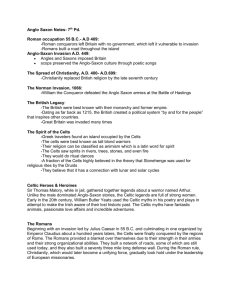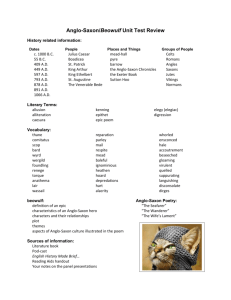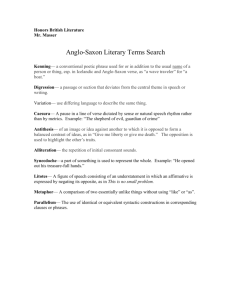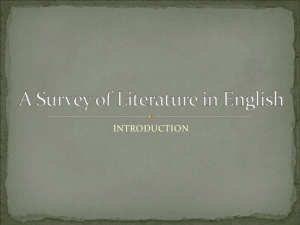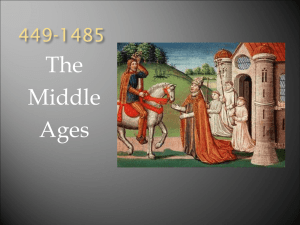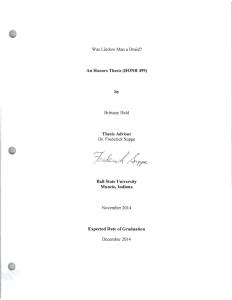Anglo-Saxons 449-1066
advertisement
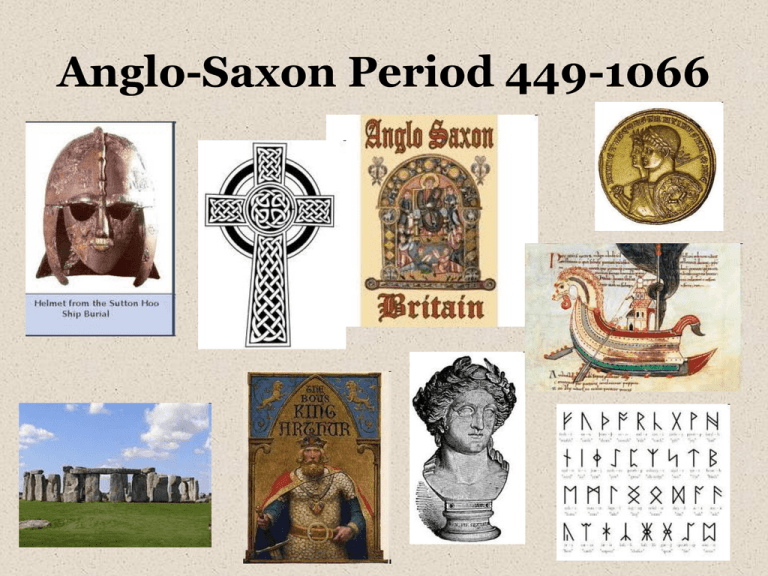
Anglo-Saxon Period 449-1066 England/Great Britain/United Kingdom • Island that includes England, Scotland and Wales •Known today as the United Kingdom of Great Britain •Invading peoples included the Iberians, Celts, Romans, Angles, Saxons. Jutes, Vikings, and Normans • from around 449-1066 The migrations of the invading peoples into England during the Anglo-Saxon period The Celts • 4th century- Celtic people called Britons invaded England • Tall, blonde warriors; women had equal rights as men • Religion based on animism (spirits live in trees, rivers, rocks, etc) • Druid priests acted as intermediaries between the people and gods • Believed in the “Great Mother Goddess” who associated with nature Stonehenge • Celtic priests (druids) were said to have built Stonehenge (a bunch of heavy stones placed in a circle) • Ceremonies celebrating the rites of the sun, moon, and astronomical events took place here • A mystery on how this monument was created • Stonehenge is one of the “Wonders of the Modern World” • Druid translates as “knowing the oak tree” because these priests performed religious ceremonies in oak groves • The oak tree and the mistletoe were sacred to the Celtic priests • The custom of kissing under the mistletoe comes from the Celtic traditition • Druid priests were also responsible for educating the young Celtic Mythology & Legend • Celtic mythology influenced the literature of England • These myths and legends are full of male and female heroes unlike the male dominated Anglo-Saxon literature schools normally teach. • The legend of King Arthur and the Knights of the Round Table come from the Celtic myths The Romans • Julius Caesar defeated the Celts (Britons) in 55 BC • The Romans occupied this area for 4 centuries • They built: ~roads that connected cities ~a defensive wall (Hadrian’s Wall) ~public baths • They promoted literacy and education • Their most important contribution was Christianity Public Baths & Hadrian’s Wall Angles, Saxons, and Jutes • Invaders from Germany (Angles and Saxons) and Denmark (Jutes) came in the 5th century • The name “England” comes from the Angle words Engla Land • The tribes and cities were not unified and they fought each other frequently • King Alfred the Great unified the tribes, established Christianity as the dominant religion, and had the Anglo-Saxon Chronicle written to record their history Anglo-Saxon Culture/Life • • • • • • • Dominated by warfare and battle Loyal to your family, tribe and leader (chief) Comitatus: loyalty between leader and thane (warrior) in order to survive People lived in close family communities for protection; kept animals/livestock inside living quarters Main responsibility of the leader: protect your people and maintain law and order Success and fame was measured in battle and by gifts the leader presented to you Courage and strength more important than intelligence or a long life Anglo-Saxon Culture/Life • • • • • Socialized in mead halls (a centralized building) where feasts, storytelling, and celebrations occurred; mead halls were “neutral” locations= no one would attack another tribe while in this communal hall Mead is a fermented alcoholic beverage mixed with honey Bard/scop (storyteller, songwriter, singer) who spread the fame of warriors from battle Bards/scops regarded on equal status with warriors because they ensured the fame of the individual or tribe by recording and retelling history Storytelling and singing took place in the mead hall celebrations Anglo-Saxon Religion/Beliefs • • • • • • • Did not believe in an “afterlife” or heaven: you earned immortality through your actions which were sung by the bards/scops Mainly concerned with ethics (sense of right and wrong) Viewed life “fatalistically” (life is hard and short) Wyrd means “fate”-your destiny is set in stone, cannot be changed: this belief made Anglo-Saxon warriors fierce and dangerous Wergild means “man price”-payment for the death of another person, “payback” or revenge for a wrong done The dragon is a symbol of evil and death; associated with guarding treasure Norse gods: “Woden”=Wednesday and “Thor”=Thursday Sutton Hoo Ship • • • • In 1939 in Suffolk, England an enormous wooden ship (1300 years old) with vast amounts of treasure was discovered by archaeologists This ship was the grave of an important king or warrior, as was the custom of AngloSaxon to bury the dead with important objects Decorated vessels in gold, silver and bronze were discovered along with battle armor and weapons, musical instruments, money and other interesting objects This discovery provided a glimpse into the life and customs of the Anglo-Saxons Sutton Hoo Beowulf: The Epic • • • • • • The first great work of English national literture The protagonist’s name if Beowulf which means “bear” Beowulf is a Geat from Sweden who goes to Daneland (Denmark) to help King Hrothgar defeat an evil monster, Grendel The epic is short only 3,200 lines (epics are usually around 15,000 lines) Composed in Old English around 700 to 750 in Northumbria The setting of the story is older from the early 6th century
